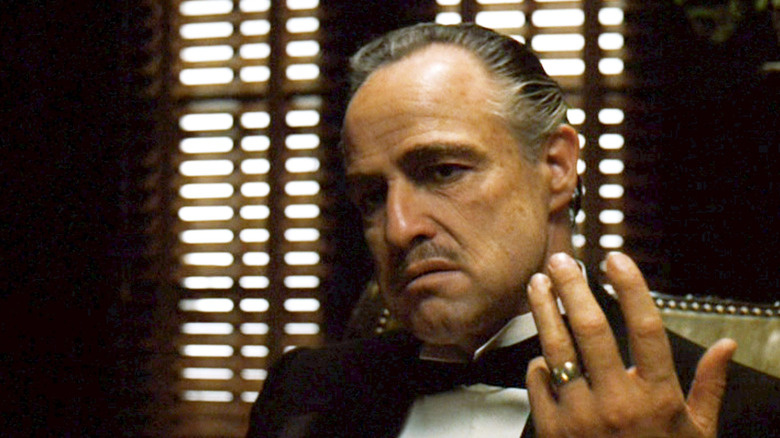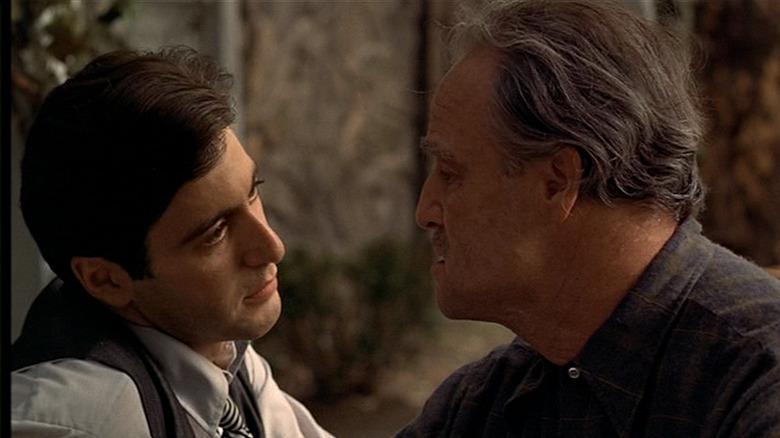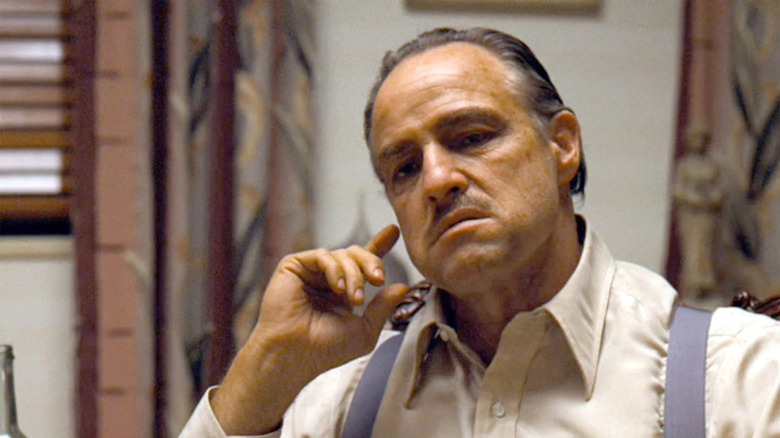Marlon Brando Built An Entire Life For The Godfather's Vito Corleone
During the casting of "The Godfather," Paramount executives did not agree with director Francis Ford Coppola's choice of Marlon Brando for the iron-willed Vito Corleone. After a string of box office failures, on-set conflicts, and personal issues, they saw him as a temperamental has-been and prima donna. In his autobiography "Songs My Mother Taught Me," Brando admits even he thought he wasn't right for the part:
"I had never played an Italian before, and I didn't think I could do it successfully. They had to be convinced that he, not someone like Ernest Borgnine or Carlo Ponti, was perfect for the role."
But Brando proved he was the ideal choice, giving a hypnotic performance of sheer intensity and measured wisdom that went on to become his most iconic and earned him the Academy Award for Best Actor (though he famously declined the trophy and sent indigenous American rights activist Sacheen Littlefeather to speak on his behalf).
Brando used his insightful method acting style to become the aging, sphinx-like patriarch of a notable mafia family. Stella Adler, one of the most renowned theatre teachers who adapted Constantin Stanislavski's lessons, taught him physical and emotional techniques to create believable characters and develop natural performances (via Backstage). Wielding his physicality and imagination — two key items in the method actor's toolbox — Brando would transform Vito Corleone from a typical villain into an eminent family man with a rich off-screen life and history.
Changing his physical appearance for the role
Stanislavski believed that actors must build their character's behavior through specific, concrete and performable actions, ones that you can observe through others (via Backstage). According to the book "Somebody: The Reckless Life and Remarkable Career of Marlon Brando," Marlon Brando put this into practice when he visited a prominent New Jersey mafioso, watching how the boss carried himself and interacted with his friends and family:
"He could see the importance of well-prepared food and vintage wine; the manner in which powerful dons spoke in quiet voices; the way the men went out of their way to be gracious to their women, but also how they kept them in secondary roles; the exaggerated politesse to a stranger, albeit a movie star; the overwhelming feeling of la famiglia — loyalty to one's own. He took mental notes that were to affect the film and everyone in it."
Brando's performance feels so authentic because he absorbed these real life details and used them to inform his portrayal of the cunning don. Taking from Stella Adler, who taught the importance of using your body to inhabit a character, Brando also transformed his appearance. He put cotton in his cheeks to emulate a formidable bulldog, darkened his hair with shoe polish, and developed a quiet, raspy voice, referencing a detail in Mario Puzo's book about Vito once being shot in the throat. These physical changes convey an older man worn down by the pressures of leadership in an increasingly violent world. His face is strong and thoughtful but gives nothing away about his feelings inside.
Crafting a different kind of gangster
In Stanislavski's "Building a Character," he explains that the outward expressions of character, their way of speaking and moving, must come from their inner life: their passions, memories, beliefs, thoughts, etc. He also encourages actors to think deeply about their character's personal history from birth until the present narrative. Brando crafts Vito as a modest and quiet man, who is (as recounted in "Somebody") "part of the wave of immigrants who came to this country around the turn of the century and had to swim upstream to survive as best they could. He had the same hopes and ambitions for his sons that Joseph P. Kennedy had for his."
Coming to America as a lonely child from rural Italy, Vito fell into the criminal lifestyle in his determined quest for the American Dream. In "The Godfather," Vito confides his ambitions to his son Michael:
"I never wanted this for you. I work my whole life, I don't apologize, to take care of my family. And I refused to be a fool, dancing on the strings held by all those big shots ... I always thought that when it was your time that you would be the one to hold the strings. Senator Corleone. Governor Corleone... Well, there wasn't enough time, Michael."
Brando approached Vito Corleone in a unique way, wanting to separate himself from other film depictions of mafia leaders:
"I thought it would be interesting to play a gangster, maybe for the first time in the movies, who wasn't like those bad guys Edward G. Robinson played, but who is kind of a hero, a man to be respected. Also, because he had so much power and unquestioned authority, I thought it would be an interesting contrast to play him as a gentle man, unlike Al Capone, who beat up people with baseball bats."
His Vito is more like the cat he fondly strokes in the beginning of "The Godfather": silent and calculating with a piercing stare. Through his physical and emotional work, Marlon Brando crafts an entire life for Vito Corleone beyond what we see on screen. This method style approach is what makes his performance so mesmerizing.


